Introduction
The University of Georgia EASY Pan (Evaporation-based Accumulator for Sprinkler-enhanced Yield) was introduced in 2001 as a simple, cost-effective alternative for scheduling irrigations on sprinkler irrigated row crops in humid regions. The EASY Pan approach has been shown to provide a reasonable comparison to other irrigation scheduling techniques while being easy to understand by the user (Thomas et al., 2003; Thomas et al., 2001). Because existing irrigation scheduling technologies have not been extensively adopted in humid regions, alternative approaches are needed that can be effectively integrated into row crop farming operations where the farm manager generally allots little time to monitor soil water conditions or water needs of the crop.
In all direct applications of the EASY Pan, one pan is expected to provide irrigation scheduling recommendations for an entire field. As with evaporation pan data from a weather station, the evaporation results from a single device are designed to represent a relatively large geographical area. The EASY pan was originally designed to use a #3 galvanized wash tub for the pan, which will hold about 17 gallons of water. Unfortunately, the person installing the EASY pan must trans-port (usually by hand) this water to the field when setting up the pan. The size was selected to allow flexibility in soil and root depth characteristics while maintaining a sufficient water supply for reduced maintenance. Screen cover materials are used to help represent the water use characteristics of different row crops while also reducing the potential loss of water to animals and preventing foreign materials from entering the pan.
Heavy-textured soils and crops with deep rooting depths can allow a significant amount of water to be removed from the pan prior to an irrigation event (Thomas et al., 2001). An in-depth presentation of the previous work can be found in UGA Cooperative Extension Bulletin 1201.
Several users have questioned the need for the larger sized tub or pan. This publication presents results of a test with two smaller pans. The potential to use a smaller unit would allow a single individual to easily set up and maintain the EASY Pan and, at the same time, reduce the overall cost of materials in the construction process. The hypothesis of this particular test was that the two smaller pans would respond in a similar manner to the larger pans under evaporation and excess rainfall conditions.
Methods and Procedures
Eighteen different galvanized pans were used. For this particular test, six #3 (large-sized) pans representing the original design (17 gallons), six #0 (medium-sized) pans (8 gal.) and six KA (small-sized) pans (4 gal.) were installed. The free water surface area on the large pan is about 460 mm2 when the pan is full (at the drain hole). Each size pan was randomly selected to have either the standard wire cover (2" wire mesh) or standard window screen (0.0625" wire mesh). See Figure 1.
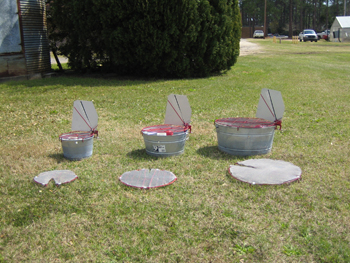
Each of the pan units uses a float which allows the water level to be represented on a float indicator arm (Thomas et al., 2004). The float unit designed for both the #3 and the #0 pans were standard brass toilet bowl floats [about 4.3" dia.]. The float unit on the KA pans was constructed from PVC material instead of using a toilet bowl float. The float dimensions are 3 inches in length and 1.5 inches in diameter with end caps glued to each end. The float dimensions were designed to provide a similar surface displacement to the floats for the other pans.
All pans were placed, leveled, and the back indicator plate attached per the installation instructions (Thomas et al., 2001). Care was taken to ensure a similar wind run and compass orientation condition for all pans. All pans were at least 3 feet from each other during the test, with a random selected location for each pan. The water level in each pan was maintained so the indicator arm attached to the float was between the black (upper) “do not irrigate” line on the back plate and the red (lower) “irrigate” line (Figure 1). For operational purposes, the black line position is designed to represent field capacity in the soil, and the red line represents the soil water deficit where irrigation should commence. If the water level in one pan in the same treatment dropped below the red line, all pans within that treatment were refilled. Periodically during the test, the pans were cleaned and restarted to maintain an oil- and debris-free surface for evaporation. No copper sulfate, dye or chlorine additives were used to reduce algae growth during this test. If algae growth became evident, all pans were cleaned and re-started.
The pans were not sheltered from rainfall, as would be representative of an actual field situation. The test was designed to evaluate the evaporation rate from each of the pans and screen covers as well as the response of the pans and covers to rainfall. Under typical evaporation conditions, the pan level would decline prior to the next reading. The water lost from each pan was considered a positive response in the graphical representations. The pans were operated for a period of two months (3 Aug. to 3 Oct.) to provide a sufficient number of days with both evaporation and rainfall. This period typically has large and medium evaporation rates in the southeast region of the United States. Irrigation events do occur during this period for row crops like peanut and cotton. During that period of testing, at least eight significant rainfall events caused the pan levels to rise prior to the next reading (rainfall amount exceeded the evaporation amount).
| Table 1. Description of EASY Pans that were tested. | ||
|
Label |
Description |
CV** |
|
L~50 |
#3, 17-gallon tub (Large) with 2" wire mesh screen |
30 |
|
L~WS |
#3, 17-gallon tub (Large) with window screen |
33 |
|
M~50 |
#0, 8-gallon tub (Medium) with 2" wire mesh screen |
18 |
|
M~WS |
#0, 8-gallon tub (Medium) with window screen |
23 |
|
S~50 |
KA, 4-gallon tub (Small) with 2" wire mesh screen |
21 |
|
S~WS |
KA, 4-gallon tub (Small) with window screen |
28 |
| * All tubs are galvanized steel; large tubs are 24" top dia., 21" bottom dia., and 11" depth; medium tubs are 18.5" top dia., 15.6" bottom dia., and 9.5" depth; small tubs are 13.5" top dia., 11" bottom dia., and 7.75" depth. Drain holes were 0.5" dia. and were drilled 3.5" from the top of the pan. ** CV is the Coefficient of Variation for the three replications of each treatment. The CV is calculated for each treatment based on the average of the individual reading CVs (SD/Mean Difference in water level for the three replications) over the entire period of study. Based on the data collection schedule, the CV represents an average 2.1 day reading interval. |
||
The variability in pan level readings within a particular treatment was analyzed using the coefficient of variation. The expectation is that the smaller pans would respond to evaporation rates (change in water level) in a similar manner to the larger pans. The analysis was made to determine if the pans of the same size and same screen material responded similarly to each other, and how the variation was different between pan sizes. For the test, at least 26 different readings were available over a two-month period of time that did not include a refill of a pan or a significant rainfall event (where a pan overflowed through the drain hole).
Results and Discussion
Response of the Smaller Pans in Comparison to the Larger Pan
The medium pan (M~50) did not respond exactly the same as the larger pan (L~50) [Figures 2 and 3]. It appears that the response due to rainfall was quite different between the two pans. There may have been a situation where all pans did not fill at the same rate when rainfall occurred (ratio of the area of the float compared to area of the pan). The small pan (S~50) responded in a similar manner to the medium pan (M~50) when compared to the large (L~50) pan.
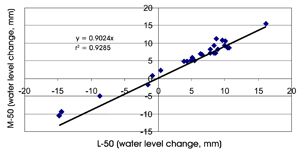 Figure 2. The relationship and linear correlation line for the average water loss or gain between the large pan (L) and the medium pan (M), both with 50 mm wire mesh screen (50).
Figure 2. The relationship and linear correlation line for the average water loss or gain between the large pan (L) and the medium pan (M), both with 50 mm wire mesh screen (50).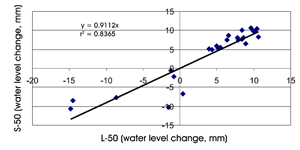 Figure 3. The relationship and linear correlation line for the average water loss or gain between the large pan (L) and the small pan (S), both with 50 mm wire mesh screen (50).
Figure 3. The relationship and linear correlation line for the average water loss or gain between the large pan (L) and the small pan (S), both with 50 mm wire mesh screen (50).
The response of the medium and small pans, respectively, as compared to the large pan when all pans have window screen is shown in Figures 4 and 5. The response of the pans to rainfall was again a factor. A large discrepancy for the rainfall impacted results was evident between the large and small pans with the window screen (Figure 5). The small pan did a better job of representing the evaporation that occurs from the large pan. If the pan is to be used exclusively for “low water use” crops (i.e., window screen and a short rod length), the small pan may be a reasonable alternative.
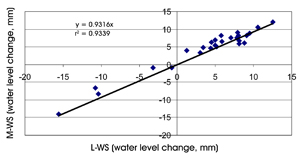 Figure 4. The relationship and linear correlation line for the average water loss or gain between the large pan (L) and the medium pan (M), both with window screen (WS).
Figure 4. The relationship and linear correlation line for the average water loss or gain between the large pan (L) and the medium pan (M), both with window screen (WS).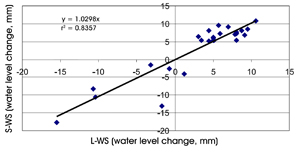 Figure 5. The relationship and linear correlation line for the average water loss or gain between the large pan (L) and the small pan (S), both with window screen (WS).
Figure 5. The relationship and linear correlation line for the average water loss or gain between the large pan (L) and the small pan (S), both with window screen (WS).
Statistical results did not show any significant differences (based on P<0.01) between the different pans, regardless of the cover screen material. The variability of the results may have been too high or the sample size may have been too small to show a significant difference if it existed.
Response Due to Rainfall
In most all the cases, test results with rainfall were very similar no matter which pan or screen was being used. Concern had been expressed by extension specialists and other researchers that the window screen material may intercept a disproportionate amount of rainfall as compared to the 2-inch mesh screen. The large discrepancies between the large and small pan results (Figures 3 and 5) are likely due to the amount of rainfall and the position of the water level in the different pans. In some cases, the water level may have quickly reached the overflow position, so additional rainfall would not be reflected in the water level reading. Other factors (surface area available for evaporation, temperature, sunlight impact on the sides of pans, etc.) likely affected the evaporation rates from the different pans. The small pan appeared to exhibit a different response to evaporation and rainfall conditions when compared to the two larger pans.
Response of Each Size Pan to Changes in the Screen Material
The relationships between water loss from the large, medium and small pans are shown in Figures 6, 7 and 8, respectively. The desired response is based on the large pan. In that case, the window screen reduced evaporation by about 13 percent when compared to the 2-inch wire mesh screen (Figure 6, Table 2). The medium pan demonstrated somewhat similar loss characteristics when using window screen as compared to the 2-inch mesh screen (Figure 7, Table 2). The small pan did not respond quite as well. One potential reason for the differences in evaporation characteristics may be the volume of water in the different pans. The small pan would be expected to have greater temperature fluctuations during the day because of the smaller volume of water. Increased evaporation may be a function of the higher temperature. The temperature of each pan was not recorded during these trials, so this potential reason is purely speculation. The small pan may be capable of providing useful irrigation scheduling recommendations if the range of the float arm is modified to reflect the different evaporation relationships.
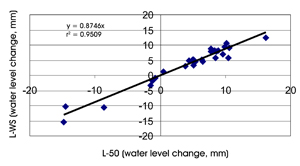 Figure 6. The relationship and linear correlation line for the average water loss or gain for the large pans (L) when comparing 50 mm wire mesh screen (50) with window screen (WS).
Figure 6. The relationship and linear correlation line for the average water loss or gain for the large pans (L) when comparing 50 mm wire mesh screen (50) with window screen (WS).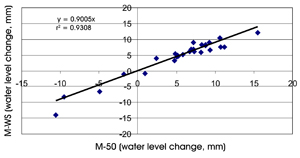 Figure 7. The relationship and linear correlation line for the average water loss or gain from the medium pans (M) when comparing 50 mm wire mesh screen (50) with window screen (WS).
Figure 7. The relationship and linear correlation line for the average water loss or gain from the medium pans (M) when comparing 50 mm wire mesh screen (50) with window screen (WS).
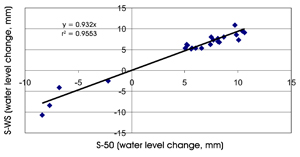 Figure 8. The relationship and linear correlation line for the average water loss or gain from the small pans (S) when comparing 50 mm wire mesh screen (50) with window screen (WS).
Figure 8. The relationship and linear correlation line for the average water loss or gain from the small pans (S) when comparing 50 mm wire mesh screen (50) with window screen (WS).
| Table 2. Summary statistical results from each comparison test. | ||||||
|
Figure # |
Scenario |
With Rainfall Values |
|
Rainfall Influenced Values Are Removed |
||
|
r2 |
Multiplier/Slope |
|
r2 |
Multiplier/Slope |
||
|
2 |
L~50 vs. M~50 |
.928 |
.902 |
|
.850 |
.982 |
|
3 |
L~50 vs. S~50 |
.836 |
.911 |
|
.612 |
.998 |
|
4 |
L~WS vs. M~WS |
.934 |
.932 |
|
.596 |
.989 |
|
5 |
L~WS vs. S~WS |
.836 |
1.03 |
|
.453 |
1.02 |
|
6 |
L~50 vs. L~WS |
.951 |
.875 |
|
.781 |
.850 |
|
7 |
M~50 vs. M~WS |
.931 |
.900 |
|
.662 |
.864 |
|
8 |
S~50 vs. S~WS |
.955 |
.932 |
|
.654 |
.917 |
Float Rod Length Affected by a Smaller Pan Size
One condition that may limit the applicability of the smaller pans is related to the float rod extension capability. In the design of the EASY Pan, heavy textured soils and deep rooted crops would allow the float rod to be extended for greater soil water holding capacity and a longer time between needed irrigations. Obviously, with a smaller pan, the float rod cannot be extended as far because the float will eventually contact the opposite side of the pan or be influenced by low water level conditions (may hit the bottom of the pan). The medium sized pan will allow the float rod to be extended to the same length as in the large pan with no limitations. The small pan would allow the float rod to be extended to only the 9-inch position.
Summary and Conclusions
Different sized pans were evaluated for their potential to be used as EASY Pans for scheduling irrigations under sprinkler systems. Medium (8 gal.) and small (4 gal.) pans were compared to the standard large (17 gal.) pan as more economical alternatives. The medium pan responded quite similarly to the large pan under both 2-inch mesh screen and window screen covering conditions. The small pan exhibited reasonable agreement for both the 2-inch wire mesh screen and for the window screen.
One potential constraint of the smallest pan is the limitation on the float rod extension. Under conditions where the effective root zone is deep, the soil water holding capacity is high, and the management allowed depletion (MAD) is large, the float rod may need to be extended to a point where the side of the pan or the depth may impact the float and the resulting readings.
In conclusion, the medium sized pan offers a potentially less expensive alternative to irrigation scheduling through the EASY Pan approach. The small pan has some limitations based on the conditions of this test. Use of the small pan, however, may be possible if the 2-inch wire mesh screen is the only one to be used, or if the parameters of the float rod degree change are modified.
References
Thomas, D. L., K. A. Harrison, J. E. Hook, and T. W. Whitley. 2001. UGA EASY Pan Irrigation Scheduler. University of Georgia, Cooperative Extension Service Bulletin 1201. 12 pp. http://pubs.caes. uga.edu/caespubs/pubcd/B1201.htm
Thomas, D. L., K. A. Harrison, and J. E. Hook. 2004. Sprinkler irrigation scheduling with the UGA EASY Pan: Performance Characteristics. Applied Engineering in Agriculture 20(4):439-445.
1 Senior Public Service Associate, Department of Biological & Agricultural Engineering, University of Georgia
2 Professor and Head, Department of Biological & Agricultural Engineering, Louisiana State University & Agricultural Center
Status and Revision History
Published on Oct 15, 2006
Published on Aug 07, 2009
Published with Full Review on Aug 01, 2012
